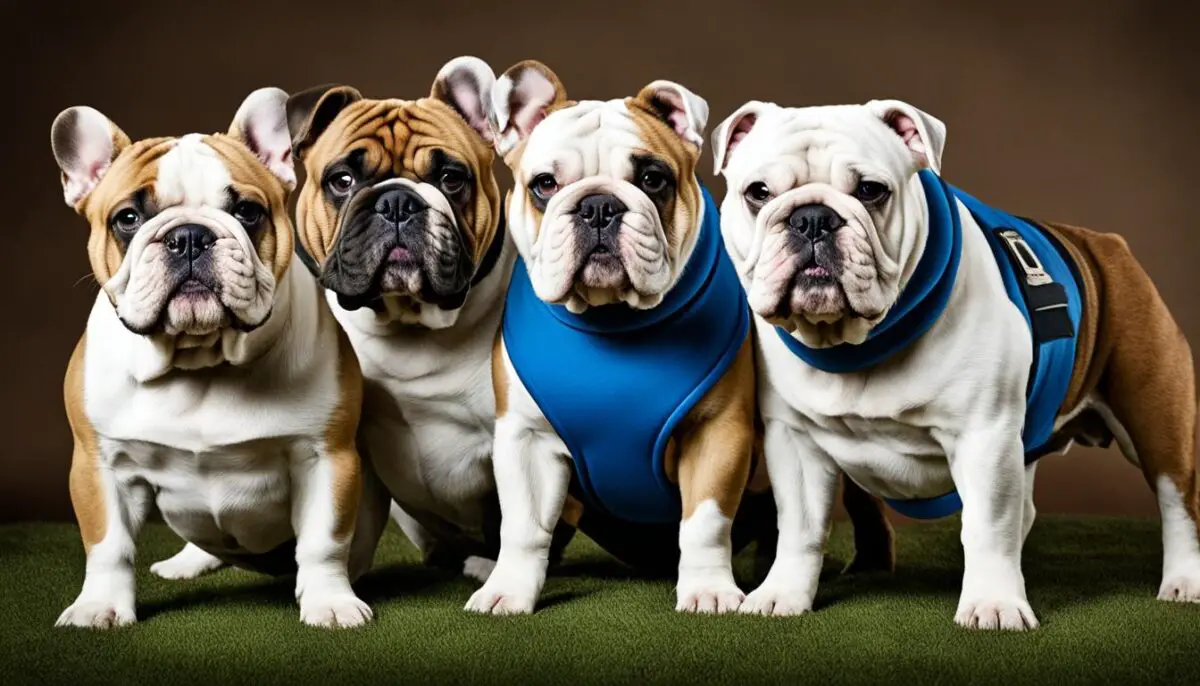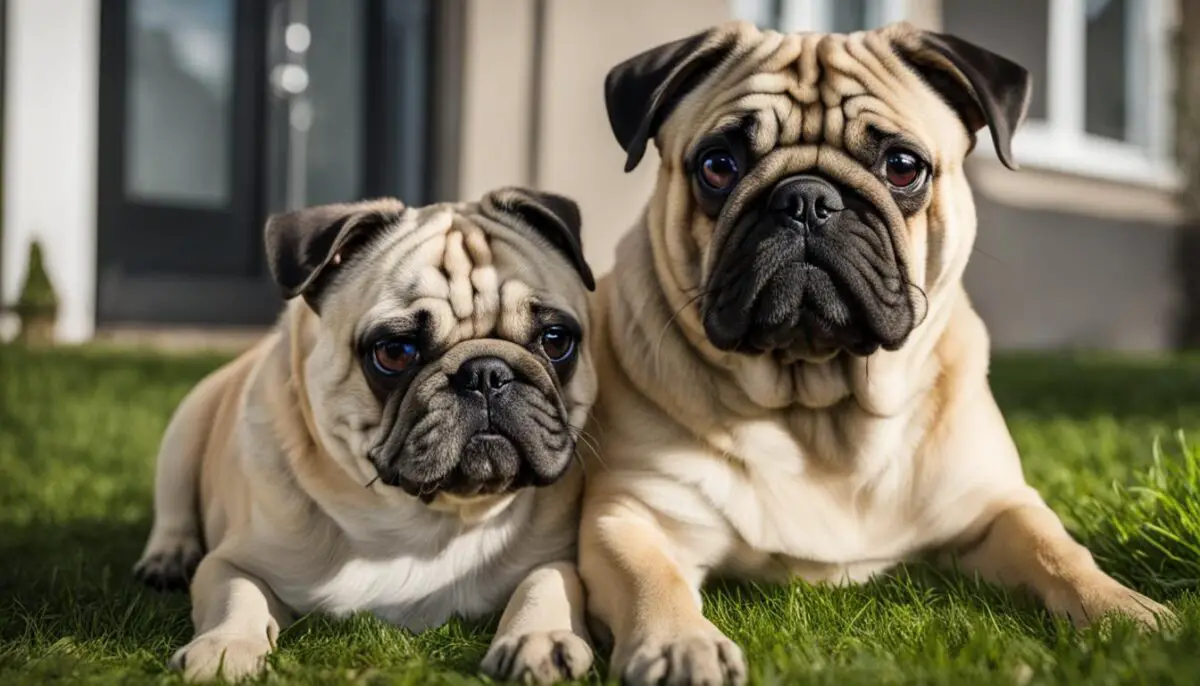Pugs and Bulldogs are beloved dog breeds that have captured the hearts of many pet owners. Known for their unique characteristics and lovable temperaments, these breeds require specific care and attention to ensure their health and happiness. In this comprehensive guide, we will delve into the history and origins of Pugs and Bulldogs, explore their distinctive qualities and temperaments, discuss common health issues they may face, and provide essential grooming tips to keep them looking their best.
Key Takeaways:
- Pugs and Bulldogs are beloved dog breeds with unique characteristics and care requirements.
- Understanding their history and origins can provide insight into their temperament and behavior.
- Both breeds are prone to certain health issues that require proactive care and regular vet check-ups.
- Proper grooming is essential to keep Pugs and Bulldogs looking and feeling their best.
- Choosing between a Pug and a Bulldog requires consideration of their distinct qualities and compatibility with your lifestyle.
History and Origins of Pugs
Pugs have a rich history that dates back over 2,000 years to ancient China. Originally bred as companions for Chinese emperors, Pugs were valued for their sociable and friendly nature. They were treasured as lap dogs and family pets, providing affection and amusement to their owners.
Pugs have distinctive characteristics that set them apart, such as their wrinkled faces and curly tails. These adorable features, along with their expressive eyes and charming personalities, make them beloved companions for people of all ages.
Known for their loving and playful temperament, Pugs are often described as mischievous and entertaining. They thrive on attention and enjoy being the center of their family’s world. Their affectionate nature makes them excellent choice for households with children and other pets.
However, it’s important to be aware of the potential health issues that Pugs may face. Due to their unique anatomy, they are more prone to respiratory problems, such as breathing difficulties and overheating, especially in hot weather or during strenuous activities.
Pugs are also susceptible to certain eye diseases, including corneal ulcers and dry eye. Regular veterinary check-ups and proactive care are essential to ensure early detection and management of these health issues.
Grooming plays a vital role in keeping Pugs looking and feeling their best. Their facial wrinkles require regular cleaning to prevent infection and odor. Additionally, their short coats benefit from regular brushing to remove loose hair and maintain a neat appearance.
Here are some pug grooming tips:
- Use a soft bristle brush to gently brush your Pug’s coat at least once a week.
- Pay special attention to their facial wrinkles and clean them gently with a damp cloth.
- Regularly trim their nails to prevent overgrowth and discomfort.
- Brush your Pug’s teeth regularly to maintain their oral health.
- Ensure your Pug receives regular baths using a gentle dog shampoo to keep their skin clean and free from irritants.
By providing proper care and attention, you can ensure that your Pug leads a happy and healthy life.
Pugs: By the Numbers
| Pug Breed Information | Statistics |
|---|---|
| Average Lifespan | 12-16 years |
| Size | Small |
| Weight | 14-18 pounds (male), 12-16 pounds (female) |
| Coat | Short, smooth, and double-layered |
| Colors | Fawn, black, apricot, silver, or brindle |
| Temperament | Playful, sociable, and affectionate |
| Exercise Needs | Moderate |

Bulldogs have unique characteristics that make them instantly recognizable. Their sturdy build, pushed-in nose, and loose skin give them an unmistakable appearance. However, these physical traits can also lead to certain health issues that bulldogs are prone to.
“Bulldogs are known for their loving nature and devotion to their families.”
One of the most common health issues bulldogs face is breathing difficulties. Their short snouts can make it challenging for them to breathe, especially in hot or humid weather. It is important to ensure they have access to cool and well-ventilated areas and to monitor them closely during exercise.
Additionally, bulldogs are susceptible to skin infections due to the folds and wrinkles on their face and body. Regular cleaning and grooming of these areas are essential to prevent bacterial or fungal growth.
Key Characteristics of Bulldogs:
- Sturdy build
- Pushed-in nose
- Loose skin
- Loving and devoted temperament
Regular grooming plays an important role in maintaining a bulldog’s overall health and well-being. Cleaning their facial folds and wrinkles with a damp cloth or specialized wipes helps to prevent irritation and infection. Brushing their coat regularly removes dead hair and keeps their fur clean and shiny.
Bulldog Health Issues:
- Breathing difficulties
- Skin infections
- Joint problems
By understanding the history, characteristics, and unique care requirements of bulldogs, owners can provide them with the love and attention they need to live a happy and healthy life.
Pug and Bulldog Comparisons
When it comes to pugs and bulldogs, these lovable breeds may share some similarities, but they also have distinct characteristics that set them apart. Understanding these differences is crucial in choosing the right dog for your household.
Pug Characteristics and Temperament
Pugs are well-known for their charming and sociable nature, making them excellent companion dogs. They have an affectionate and loving disposition, making them great with children and other pets. Pugs are adaptable and can thrive in various living situations, whether in an apartment or a larger home. Their friendly and outgoing personality makes them a popular choice for families seeking a loyal and playful four-legged friend.
Bulldog Characteristics and Temperament
Bulldogs possess a calm and gentle demeanor that often belies their tough and robust appearance. They are often described as “tough on the outside, but soft on the inside.” Bulldogs are known for their incredible loyalty and protective nature, making them excellent family companions. Their affectionate and patient temperament makes them particularly well-suited for households with children. Bulldogs are known to form strong bonds with their families and are always ready to shower them with love and devotion.
“Pugs are charming and sociable, while Bulldogs are calm and gentle. Each breed brings its own unique qualities and temperament to the table.”
Both pugs and bulldogs have their own distinct personalities, and it’s important to consider these differences when deciding which breed is the right fit for your lifestyle and preferences. While pugs are more outgoing and adaptable, bulldogs bring a sense of calmness and loyalty to the table.
Pug and Bulldog Comparison Table
| Attributes | Pug | Bulldog |
|---|---|---|
| Affectionate Nature | ✓ | ✓ |
| Sociable | ✓ | ✓ |
| Adaptability | ✓ | – |
| Loyal | – | ✓ |
| Protective | – | ✓ |
| Playfulness | ✓ | – |
As seen in the comparison table, pugs and bulldogs share some common traits such as affectionate nature and sociability. However, there are differences in adaptability, loyalty, protectiveness, and playfulness. These distinctions highlight the unique qualities that each breed brings, allowing potential owners to choose based on their preferences and lifestyle.
Before welcoming a pug or bulldog into your home, make sure to consider the breed’s characteristics, temperament, and care requirements. Both breeds require love, attention, and proper care to thrive and live happy, healthy lives.

Stay tuned for the next section, where we will explore the specific health issues that pugs and bulldogs may face.
Health Issues in Pugs and Bulldogs
Pugs and Bulldogs are beloved dog breeds with their own unique charm. However, their distinctive anatomy can make them susceptible to certain health issues. Understanding and addressing these health concerns is essential for their overall well-being.
Pug Health Issues
Pugs are brachycephalic dogs, meaning they have short snouts, which can lead to respiratory problems. Their shortened air passages make it difficult for them to breathe properly, especially in hot or humid weather. Pugs are also prone to eye issues, such as corneal ulcers and dry eye, which require regular monitoring and treatment.
Bulldog Health Issues
Bulldogs also face specific health challenges due to their unique anatomy. They may suffer from brachycephalic airway syndrome, which can cause breathing difficulties and make exercise strenuous for them. Bulldogs are also prone to skin infections, allergies, and joint problems, such as hip dysplasia. Regular vet check-ups and proactive care are vital to manage and minimize these health issues.
To ensure the well-being of your pug or bulldog, it is essential to provide them with proper medical care. Regular visits to the vet, along with proactive monitoring and management of their health issues, will help keep them happy and healthy.
| Pug Health Issues | Bulldog Health Issues |
|---|---|
| Respiratory problems | Breathing difficulties |
| Eye issues (corneal ulcers, dry eye) | Skin infections |
| Joint problems (hip dysplasia) |
Grooming Tips for Pugs and Bulldogs
Proper grooming is essential for both pugs and bulldogs to keep their coats and skin healthy. Regular grooming routines not only enhance their appearance but also promote their overall well-being. Here are some essential grooming tips for pugs and bulldogs:
Grooming Pugs
- Cleaning Facial Wrinkles: Pugs have adorable facial wrinkles that require regular cleaning to prevent infection and odor. Gently wipe the wrinkles with a soft, damp cloth or specialized pet wipes. Avoid using harsh chemicals or over-cleaning, as it may cause irritation.
- Brushing Their Coat: Pugs have short coats that shed moderately. Regular brushing helps remove loose hair, distribute natural oils, and maintain a neat appearance. Use a soft brush or grooming mitt to gently brush their coat in the direction of hair growth.
- Bathing: Pugs generally do not require frequent baths unless they get dirty or develop a strong odor. Use a gentle, dog-friendly shampoo and lukewarm water when bathing them. Be sure to dry their coat thoroughly, especially in their facial folds, as trapped moisture can lead to skin issues.
- Dental Care: Pugs are prone to dental problems, so regular dental care is crucial. Brush their teeth with a dog-friendly toothpaste and toothbrush designed for pets. Additionally, provide dental chews or toys that promote oral hygiene.
Grooming Bulldogs
- Cleaning Facial Folds: Bulldogs have adorable facial folds that require regular cleaning to prevent infection and odor. Gently wipe the folds with a damp cloth or specialized pet wipes. Ensure thorough drying to prevent moisture-related issues.
- Brushing Their Coat: Bulldogs have short, dense coats that shed moderately. Regular brushing helps remove dead hair, stimulate the skin, and promote a healthy shine. Use a soft-bristle brush or grooming glove to gently brush their coat.
- Bathing: Bulldogs should be bathed regularly to keep their skin clean and free from irritants. Use a mild shampoo formulated for dogs and warm water. Pay close attention to their facial folds, tail pocket, ears, and underbelly. Thoroughly dry their coat, including all the wrinkles, to prevent any skin problems.
- Dental Care: Bulldogs are prone to dental issues, so regular dental care is essential. Brush their teeth with a dog-friendly toothpaste and toothbrush. Offer dental treats or toys that help maintain their oral hygiene.
Remember, grooming sessions provide an excellent opportunity to bond with your pug or bulldog while ensuring their health and happiness. If you are unsure about specific grooming techniques or face any challenges, consult a professional groomer or veterinarian for guidance.
| Grooming Tips for Pugs | Grooming Tips for Bulldogs |
|---|---|
| Clean facial wrinkles regularly | Clean facial folds regularly |
| Brush their short coat to remove loose hair | Brush their dense coat to remove dead hair |
| Occasional baths when necessary | Regular baths to keep the skin clean |
| Pay attention to dental care | Maintain proper dental hygiene |
Conclusion
Pugs and bulldogs are fascinating breeds that captivate dog lovers with their unique charm and lovable personalities. Understanding their breed information, characteristics, temperament, health issues, and grooming tips is essential for providing them with the care they need.
Regular grooming, such as cleaning their facial folds and wrinkles, and brushing their coats, is crucial for maintaining their hygiene and appearance. Additionally, proactive healthcare, including regular vet check-ups and addressing breed-specific health concerns, ensures their overall well-being.
Whether you choose a pug or a bulldog, both breeds make delightful companions. Their sociable nature, affectionate demeanor, and loyalty to their families are qualities that make them beloved pets. With the right care, attention, and love, these charming dogs will thrive and bring joy to your home for years to come.
FAQ
What is the history and origin of pugs?
Pugs have a rich history that dates back over 2,000 years to ancient China. They were originally bred as companions for Chinese emperors and were treasured as lap dogs and family pets.
What are the distinctive characteristics and temperament of pugs?
Pugs have distinctive characteristics like wrinkled faces and curly tails. They are known for their loving and playful temperament, and they are adaptable and get along well with children and other pets.
What health issues are pugs prone to?
Pugs are prone to respiratory problems, eye diseases, and other health issues. Regular vet check-ups and proactive care are crucial to keep them healthy.
What grooming tips are recommended for pugs?
Pugs require regular cleaning of their facial wrinkles and folds to prevent infection and odor. Their short coats need regular brushing to remove loose hair and maintain a neat appearance.
What is the history and origin of bulldogs?
Bulldogs have a fascinating history that goes back centuries. They were originally used for bull-baiting and were bred for their tenacity and strength.
What are the distinctive characteristics and temperament of bulldogs?
Bulldogs have unique characteristics like a sturdy build, pushed-in nose, and loose skin. They have a calm and gentle demeanor and are known for their loving nature and devotion to their families.
What health issues are bulldogs prone to?
Bulldogs are prone to breathing difficulties, skin infections, and joint problems. Regular vet check-ups and proactive care are crucial for their well-being.
What grooming tips are recommended for bulldogs?
Bulldogs also need regular cleaning of their facial folds and wrinkles. Their coats require regular brushing to remove dead hair and promote a healthy shine.
